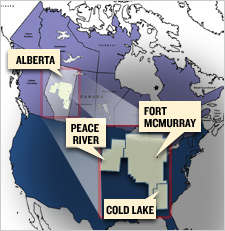|
Curing oil sands fever Despite wide-eyed predictions, serious constraints remain in developing Alberta's heavy oil. NEW YORK (CNNMoney.com) -- The answer to America's oil addiction lies in Canada. Or so goes one line of thinking. As oil supplies got tighter and crude prices soared over the last few years, tens of billions of dollars flowed into an effort to develop the biggest oil reserve outside Saudi Arabia: Alberta's oil sands.
Along with the development rush have come rosy predictions on how much this secure, close, proven supply of oil might yield. Four million, 6 million, even 10 million barrels a day, which is nearly half America's total daily consumption and would easily replace all imports from the Middle East. The only thing is, those numbers may be far too high. Making a barrel of clean, light crude from the thick, dirty oil sand uses massive amounts of water, massive amounts of electricity and requires a large pool of labor in an otherwise sparsely populated area. "People jump to the assumption that we can immediately ramp up to 9 million barrels per day and save the world," said Peter Tertzakian, chief energy economist at ARC Financial, a Calgary-based private equity firm. "But it's just not going to happen." Stuck in the sand This isn't to say the oil sands won't be a viable energy source. Two hundred miles north of Edmonton, covering an area roughly the size of Florida, they already produce more than 1 million barrels a day. U.S. majors ConocoPhillips (Charts) and ExxonMobil (Charts), as well as Royal Dutch Shell (Charts), have interests in the area, although Canadian firm Suncor (Charts) and the consortium Syncrude are the biggest players. Getting a product similar to light crude usually involves one of two methods. The first uses a model borrowed from open-pit mining, in which the sands are dug out of the ground with heavy equipment, then mixed with steam, hot water and caustic soda to create a slurry. The slurry then enters a separation tank where bitumen, the valuable product in this process, rises to the top and is skimmed off. The bitumen is then heated again to remove impurities, resulting in a synthetic light, sweet crude that's easy to refine. The other method uses a well to inject steam into a seam of oil sand deep below the earth's surface. The resulting slurry then drains down into a second well drilled below the first, where it's pumped to the surface. This eliminates the need to strip-mine the area, but creating the needed steam uses vast amounts of energy. And energy is the first limitation people bring up at the mention of the oil sands. Tertzakian said it takes the equivalent of 0.7 barrels of oil to create one barrel of oil sands product. What's more, most of the energy needed to make the stuff currently comes from natural gas, an energy-rich, clean fossil fuel. "It's like using caviar to make fake crab meat," said Marlo Raynolds, executive director of the Pembina Institute, a Canadian environmental group. Experts say most of the natural gas Canada currently exports to the United States will be eaten up by the oil sands projects. To fuel further expansion, they say, Canada will have to import natural gas from Alaska. Some have even suggested going nuclear, although that idea has gained little traction so far. Another constraint is water. Both extracting methods use huge amounts, up to two barrels for every barrel of oil produced. Even with production running at one million barrels a year, concerns are already being raised over the drawdown from the major rivers that flow through the region. "At some point it's going to reach a tipping point when people say enough is enough," said Raynolds. And then there's the labor question. If you're looking to make truckloads of money doing mindless work, head to Fort McMurray, the biggest town close to the oil sands. A quick read of the classifieds at the town's newspaper turns up jobs selling concessions at the movie theatre paying the equivalent of U.S. $10 an hour. Janitor positions start at $17. For more skilled workers, a welder can bring in $80,000 a year, more than double the average in the U.S. And that's without overtime. "We now have signing bonuses for people who work in coffee shops," said Tertzakian. "We just don't have the labor pool to match $90 billion in investment." Measured steps So how much can they pull from the ground in Alberta? The Canadian government and many of the companies up there put the number somewhere around 4 million barrels per day by 2015, still a significant amount roughly equal to America's total crude production. "The production levels aren't unrealistic at all, it's just a question of time," said Sheraz Mian, a senior oil and natural gas analyst at Zacks Investment Research. But others are less sanguine. The U.S. Energy Information Administration, not generally known for issuing bearish reports, puts the number at 2.3 million barrels per day by 2015. Tertzakian estimates maybe 2.5 to 3 million barrels per day and cautions against too much optimism. "Nobody should feel comfortable that Canada's oil sands are going to single-handedly satisfy the world's energy needs," he said. __________________ |
|



